Chevrolet Cruze 2019 Owner's Manual
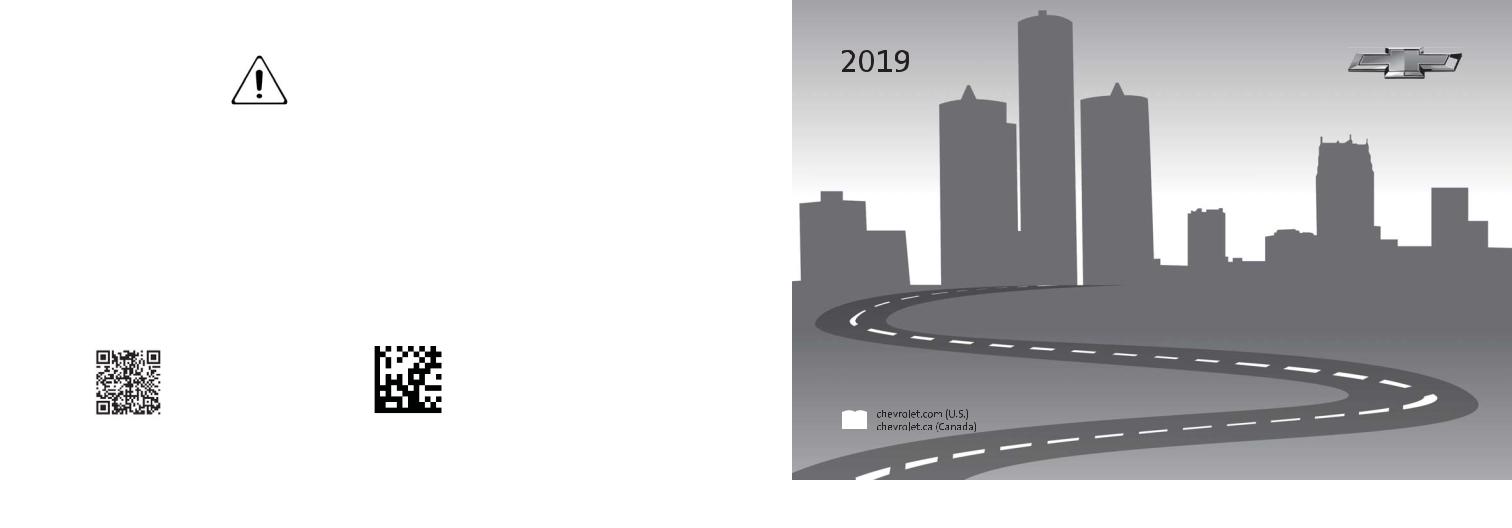
Cruze
Owner’s Manual

Contents
Introduction . . . . . . . . . . . . . . . . . . . . . . 2
In Brief . . . . . . . . . . . . . . . . . . . . . . . . . . . 5
Keys, Doors, and Windows . . . . . 28
Seats and Restraints . . . . . . . . . . . 57
Storage . . . . . . . . . . . . . . . . . . . . . . . 106
Instruments and Controls . . . . . . 109
Lighting . . . . . . . . . . . . . . . . . . . . . . . 144
Infotainment System . . . . . . . . . . 151
Climate Controls . . . . . . . . . . . . . . 152
Driving and Operating . . . . . . . . . 159
Vehicle Care . . . . . . . . . . . . . . . . . . 229
Service and Maintenance . . . . . 323
Technical Data . . . . . . . . . . . . . . . . 338
Customer Information . . . . . . . . . 342
Reporting Safety Defects . . . . . . 352
OnStar . . . . . . . . . . . . . . . . . . . . . . . . 356
Connected Services . . . . . . . . . . . 364
Index . . . . . . . . . . . . . . . . . . . . 368

2Introduction
Introduction
The names, logos, emblems, slogans, vehicle model names, and vehicle body designs appearing in this manual including, but not limited to, GM, the GM logo, CHEVROLET, the CHEVROLET Emblem, and CRUZE are trademarks and/or service marks of General Motors LLC, its subsidiaries, affiliates,
or licensors.
For vehicles first sold in Canada, substitute the name “General Motors of Canada Company” for Chevrolet Motor Division where it appears in this manual.
This manual describes features that may or may not be on the vehicle because of optional equipment that was not purchased on the vehicle, model variants, country specifications, features/applications that may not be available in your region, or changes subsequent to the printing of this owner’s manual.
Refer to the purchase documentation relating to your specific vehicle to confirm the features.
Keep this manual in the vehicle for quick reference.
Canadian Vehicle Owners
A French language manual can be obtained from your dealer, at www.helminc.com, or from:
Propriétaires Canadiens
On peut obtenir un exemplaire de ce guide en français auprès du concessionnaire ou à l'adresse suivante:
Helm, Incorporated
Attention: Customer Service
47911 Halyard Drive
Plymouth, MI 48170
USA
Using this Manual
To quickly locate information about the vehicle, use the Index in the back of the manual. It is an alphabetical list of what is in the manual and the page number where it can be found.
Litho in U.S.A. |
© 2018 General Motors LLC. All Rights Reserved. |
Part No. 84169515 A First Printing |

Introduction 3
Danger, Warning, and
Caution
Warning messages found on vehicle labels and in this manual describe hazards and what to do to avoid or reduce them.
{Danger
Danger indicates a hazard with a high level of risk which will result in serious injury or death.
{Warning
Warning indicates a hazard that could result in injury or death.
Caution
Caution indicates a hazard that could result in property or vehicle damage.
A circle with a slash through it is a safety symbol which means “Do Not,” “Do not do this,” or “Do not let this happen.”
Symbols
The vehicle has components and labels that use symbols instead of text. Symbols are shown along with the text describing the operation or information relating to a specific component, control, message, gauge, or indicator.
M : Shown when the owner’s manual has additional instructions or information.
* : Shown when the service manual has additional instructions or information.
0 : Shown when there is more information on another page — “see page.”
Vehicle Symbol Chart
Here are some additional symbols that may be found on the vehicle and what they mean. See the features in this manual for information.
u : Air Conditioning System
G : Air Conditioning Refrigerant Oil
9 : Airbag Readiness Light
! : Antilock Brake System (ABS) $ : Brake System Warning Light
9: Dispose of Used Components Properly
P: Do Not Apply High Pressure Water
B : Engine Coolant Temperature
_ : Flame/Fire Prohibited
H : Flammable
[: Forward Collision Alert
R: Fuse Block Cover Lock Location
+ : Fuses
j : ISOFIX/LATCH System Child Restraints

4Introduction
Q: Keep Fuse Block Covers
Properly Installed
|: Lane Change Alert
@ : Lane Departure Warning
A : Lane Keep Assist
* : Malfunction Indicator Lamp
: : Oil Pressure
X: Park Assist
~ : Pedestrian Ahead Indicator
O : Power
7: Rear Cross Traffic Alert
I : Registered Technician
/ : Remote Vehicle Start
> : Seat Belt Reminders
I : Side Blind Zone Alert
h : Stop/Start
7 : Tire Pressure Monitor
d : Traction Control/StabiliTrak/
Electronic Stability Control (ESC)
a : Under Pressure
V: Vehicle Ahead Indicator

In Brief |
5 |
In Brief
Instrument Panel
Instrument Panel Overview . . . . . . 6
Initial Drive Information
Initial Drive Information . . . . . . . . . . 8
Stop/Start System . . . . . . . . . . . . . . . 8
Remote Keyless Entry (RKE)
System . . . . . . . . . . . . . . . . . . . . . . . . 8
Remote Vehicle Start . . . . . . . . . . . 9
Door Locks . . . . . . . . . . . . . . . . . . . . . 9
Trunk . . . . . . . . . . . . . . . . . . . . . . . . . . 10
Windows . . . . . . . . . . . . . . . . . . . . . . . 10
Seat Adjustment . . . . . . . . . . . . . . . 11
Heated Seats . . . . . . . . . . . . . . . . . . 13
Head Restraint Adjustment . . . . 13
Seat Belts . . . . . . . . . . . . . . . . . . . . . 13
Passenger Sensing System . . . 14
Mirror Adjustment . . . . . . . . . . . . . . 14
Steering Wheel Adjustment . . . . 15
Interior Lighting . . . . . . . . . . . . . . . . 15
Exterior Lighting . . . . . . . . . . . . . . . 16
Windshield Wiper/Washer . . . . . . 17
Climate Controls . . . . . . . . . . . . . . . 18
Transmission . . . . . . . . . . . . . . . . . . 20
Vehicle Features
Infotainment System . . . . . . . . . . . 21
Steering Wheel Controls . . . . . . . 21
Cruise Control . . . . . . . . . . . . . . . . . 21
Driver Information
Center (DIC) . . . . . . . . . . . . . . . . . 22
Forward Collision Alert (FCA)
System . . . . . . . . . . . . . . . . . . . . . . . 22
Forward Automatic
Braking (FAB) . . . . . . . . . . . . . . . . 22
Front Pedestrian Braking (FPB)
System . . . . . . . . . . . . . . . . . . . . . . . 22
Lane Keep Assist (LKA) . . . . . . . 23
Lane Change Alert (LCA) . . . . . . 23
Rear Vision Camera (RVC) . . . . 23
Rear Cross Traffic Alert (RCTA)
System . . . . . . . . . . . . . . . . . . . . . . . 23
Park Assist . . . . . . . . . . . . . . . . . . . . 23
Power Outlets . . . . . . . . . . . . . . . . . 24
Sunroof . . . . . . . . . . . . . . . . . . . . . . . . 24
Performance and Maintenance
Traction Control/Electronic Stability Control . . . . . . . . . . . . . . 25
Tire Pressure Monitor . . . . . . . . . . 25 Fuel (Gasoline) . . . . . . . . . . . . . . . . 26 Fuel (Diesel) . . . . . . . . . . . . . . . . . . . 26 E85 or FlexFuel . . . . . . . . . . . . . . . . 26
Engine Oil Life System . . . . . . . . 26 Driving for Better Fuel
Economy . . . . . . . . . . . . . . . . . . . . . 27 Roadside Assistance
Program . . . . . . . . . . . . . . . . . . . . . . 27
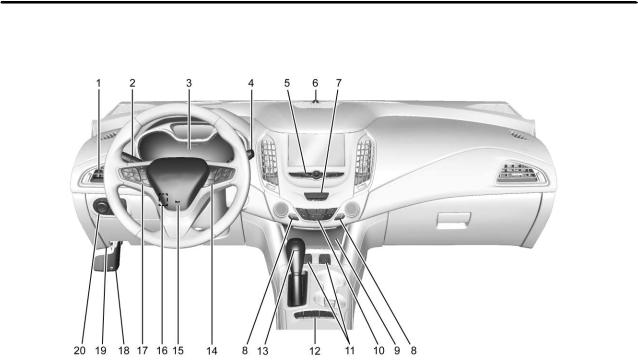
6In Brief
Instrument Panel
Instrument Panel Overview

In Brief |
7 |
1.Air Vents 0 157.
2.Headlamp High/Low-Beam Changer 0 146.
Turn Signal Lever. See Turn and Lane-Change Signals 0 148.
Driver Information Center (DIC) Buttons (If Equipped).
See Driver Information Center (DIC) (Base Level) 0 132 or Driver Information Center (DIC) (Uplevel) 0 135.
3.Instrument Cluster 0 115.
4.Windshield Wiper/Washer 0 111.
5.Infotainment 0 151.
6.Light Sensor. See Automatic Headlamp System 0 146.
7.Hazard Warning Flashers 0 147.
8.Heated Front Seats 0 62 (If Equipped).
9.Instrument Panel Fuse Block 0 268.
10.Climate Control Systems 0 152.
Automatic Climate Control System 0 154 (If Equipped).
11.Power Outlets 0 113.
USB Port. See the infotainment manual.
12.Traction Control/Electronic Stability Control 0 196.
Assistance Systems for Parking or Backing 0 202.
Stop/Start Disable Button. See
Stop/Start System 0 178.
13.Shift Lever. See Automatic Transmission 0 190.
14.Steering Wheel Controls 0 110.
Driver Information Center (DIC) Controls (If Equipped).
See Driver Information Center (DIC) (Base Level) 0 132 or Driver Information Center (DIC) (Uplevel) 0 135.
15.Horn 0 110.
16.Steering Wheel Adjustment
0 110 (Out of View).
17.Cruise Control 0 198.
Heated Steering Wheel 0 110
(If Equipped).
Forward Collision Alert (FCA) System 0 204 (If Equipped).
Lane Keep Assist (LKA) 0 212
(If Equipped).
18.Hood Release. See Hood
0 232.
19.Data Link Connector (DLC) (Out of View). See Malfunction Indicator Lamp (Check Engine Light) 0 124.
20.Exterior Lamp Controls 0 144.
Fog Lamps 0 148 (If Equipped).
Instrument Panel Illumination Control 0 149.
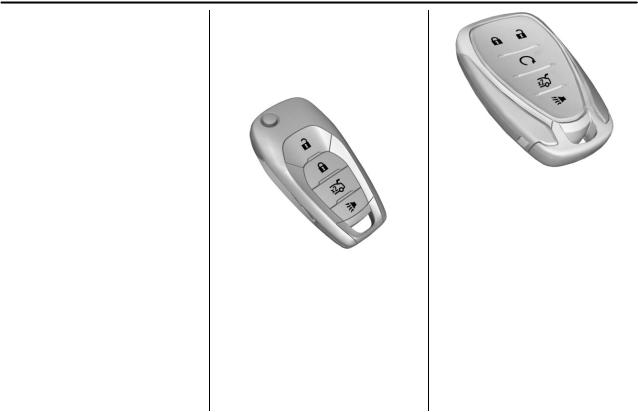
8In Brief
Initial Drive
Information
This section provides a brief overview about some of the important features that may or may not be on your specific vehicle.
For more detailed information, refer to each of the features which can be found later in this owner’s manual.
Stop/Start System
The Stop/Start system will shut off the engine to help conserve fuel.
It has components designed for the increased number of starts.
When the brakes are applied and the vehicle is at a complete stop, the engine may turn off. When stopped, the tachometer displays AUTO STOP. See Tachometer
0 119. When the brake pedal is released or the accelerator pedal is pressed, the engine will restart. See
Stop/Start System 0 178.
Remote Keyless Entry
(RKE) System
The Remote Keyless Entry (RKE) transmitter may work up to 60 m (197 ft) away from the vehicle.
Flip Key
Press the key release button to extend the key blade. The key can be used for the ignition and all locks.
Keyless Access
Press the key release button to remove the key. The key can be used for all locks.
Press K to unlock the driver door. Press unlock again within
five seconds to unlock all doors, depending on vehicle personalization. See Vehicle Personalization 0 139.
Press Q to lock all doors.
Lock and unlock feedback can be personalized. See Vehicle Personalization 0 139.

In Brief |
9 |
Press X twice quickly to open the trunk or liftgate.
Press and hold 7 briefly to initiate vehicle locator.
Press and hold 7 for at least three seconds to sound the panic alarm.
Press 7 again to cancel the panic alarm.
See Keys 0 28 and Remote Keyless Entry (RKE) System Operation (Keyless Access) 0 31 or Remote Keyless Entry (RKE) System Operation (Key Access) 0 38.
Remote Vehicle Start
If equipped, the engine can be started from outside of the vehicle.
Starting the Vehicle
1.Press and release Q on the RKE transmitter.
2.Immediately press and hold / for at least four seconds or until the turn signal lamps flash.
Start the vehicle normally after entering.
When the vehicle starts, the parking lamps will turn on.
Remote start can be extended.
Canceling a Remote Start
To cancel a remote start, do one of the following:
.Press and hold / until the parking lamps turn off.
.Turn on the hazard warning flashers.
. Turn the vehicle on and then off.
See Remote Vehicle Start 0 40.
Door Locks
To lock or unlock the vehicle from the outside:
.Use the key. The key lock cylinder is covered with a cap. See Door Locks 0 42.
.Press Q or K on the Remote Keyless Entry (RKE) transmitter.
To lock or unlock the vehicle from the inside, use the power door lock switch.
Power Door Locks
K : Press to unlock the doors.
Q : Press to lock the doors.

10 In Brief
Keyless Access |
Trunk |
Windows |
If equipped, press the button on the driver door handle when the RKE transmitter is within 1 m (3 ft) of the driver door handle. When unlocking from the driver door, the first press unlocks that door; press again within five seconds to unlock all passenger doors. See Remote Keyless Entry (RKE) System Operation (Keyless Access) 0 31 or Remote Keyless Entry (RKE) System Operation (Key Access)
0 38.
To open the trunk:
.Press the trunk release button on the driver door.
.Press X twice on the Remote Keyless Entry (RKE) transmitter.
.Press the touch pad on the trunk above the license plate after unlocking all doors.
See Trunk 0 46.
The power windows work when the ignition is on, in ACC/ACCESSORY, or when Retained Accessory Power (RAP) is active. See Retained Accessory Power (RAP) 0 180.
Using the window switch, press to open or pull to close the window.
The windows may be temporarily disabled if they are used repeatedly within a short time.
See Power Windows 0 53.

In Brief |
11 |
Seat Adjustment |
Seat Height Adjuster |
Reclining Seatbacks |
Manual Front Seats
To adjust a manual seat:
1.Pull the handle at the front of the seat.
2.Slide the seat to the desired position and release the handle.
3.Try to move the seat back and forth to be sure it is locked in place.
If equipped, move the lever up or down to manually raise or lower the seat.
See Seat Adjustment 0 59.
To recline the manual seatback:
1.Lift the lever.
2.Move the seatback to the desired position, then release the lever to lock the seatback in place.
3.Push and pull on the seatback to make sure it is locked.

12 In Brief
To return the seatback to an upright position:
1.Lift the lever fully without applying pressure to the seatback, and the seatback returns to the upright position.
2.Push and pull on the seatback to make sure it is locked.
To recline a power seatback, if equipped:
.Tilt the top of the control rearward to recline.
.Tilt the top of the control forward to raise.
See Reclining Seatbacks 0 60.
Power Driver Seat
To adjust a power driver seat, if equipped:
.Move the seat forward or rearward by sliding the control forward or rearward.
.Raise or lower the front part of the seat cushion by moving the front of the control up or down.
.Raise or lower the entire seat by moving the rear of the control up or down.
See Power Seat Adjustment 0 60.
Rear Seats
The rear seatbacks can be folded.
For detailed instructions, see Rear Seats 0 63.

In Brief |
13 |
Heated Seats
If equipped, the controls are on the center stack. The engine must be running to operate the heated seats.
Press M or L to heat the driver or passenger seat cushion.
Press the control once for the highest setting. With each press of the control, the heated seat will change to the next lower setting, and then the off setting. Three lights indicate the highest setting and one light the lowest.
See Heated Front Seats 0 62.
Head Restraint
Adjustment
Do not drive until the head restraints for all occupants are installed and adjusted properly.
To achieve a comfortable seating position, change the seatback recline angle as little as necessary while keeping the seat and the head restraint height in the proper position.
See Head Restraints 0 58 and Seat
Adjustment 0 59.
Seat Belts
Refer to the following sections for important information on how to use seat belts properly:
.Seat Belts 0 66
.How to Wear Seat Belts Properly 0 67
.Lap-Shoulder Belt 0 69
.Lower Anchors and Tethers for Children (LATCH System) 0 92

14 In Brief
Passenger Sensing
System
United States
Canada
The passenger sensing system turns off the front outboard passenger frontal airbag and knee airbag under certain conditions. No other airbag is affected by the passenger sensing system. See
Passenger Sensing System 0 79 for important information.
The passenger airbag status indicator will be visible on the overhead console when the vehicle is started. See Passenger Airbag Status Indicator 0 123.
Mirror Adjustment
Exterior
1.Turn the control knob to L (Left) or R (Right) to choose the driver or passenger mirror.
2.Move the control knob up, down, left, or right to adjust the mirror.
See Power Mirrors 0 52.
If the vehicle has heated mirrors, see Heated Mirrors 0 52.
Interior Mirror
Adjustment
Adjust the rearview mirror to view the area behind the vehicle.
Manual Rearview Mirror
If equipped with a manual rearview mirror, push the tab forward for daytime use and pull it for nighttime use to avoid glare from the headlamps from behind. See
Manual Rearview Mirror 0 53.
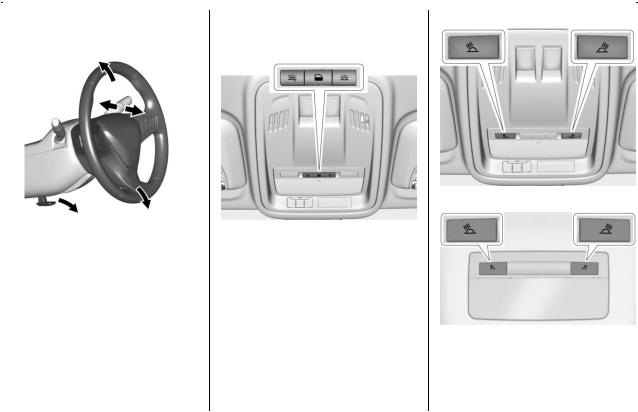
In Brief |
15 |
Steering Wheel |
Interior Lighting |
Adjustment |
Dome Lamps |
|
To adjust the steering wheel:
1.Pull the lever down.
2.Move the steering wheel up or down.
3.Pull or push the steering wheel closer or away from you.
4.Pull the lever up to lock the steering wheel in place.
Do not adjust the steering wheel while driving.
( : Press to turn the lamps off, even when a door is open.
H : Press to turn the lamps on automatically when a door is opened.
' : Press to turn on the dome lamps.
Reading Lamps
Front Reading Lamps
Rear Reading Lamps, If Equipped
There are front reading lamps on the overhead console and rear reading lamps in the headliner, if equipped.

16 In Brief
# or $ : Press the button near each lamp to turn it on or off.
Instrument Panel Illumination
Control
This feature controls the brightness of the instrument panel controls and the infotainment display. The thumbwheel is to the left of the steering column on the instrument panel.
D : Move the thumbwheel up or down and hold, to brighten or dim the instrument panel controls and infotainment display.
Exterior Lighting
The exterior lamp control is to the left of the steering column on the instrument panel.
O : Turns the exterior lamps off and deactivates the AUTO mode. Turn
to O again to reactivate the AUTO mode.
In Canada, the headlamps will automatically reactivate when the vehicle is shifted out of P (Park).
AUTO : Turns the headlamps on automatically at normal brightness, together with the parking lamps, taillamps, license plate lamps, instrument panel lights, and sidemarker lamps.
; : Turns on the parking lamps including all lamps, except the headlamps.
5 : Turns on the headlamps together with the parking lamps and instrument panel lights. A warning chime sounds if the driver door is opened when the ignition switch is off and the headlamps are on.
9 : If equipped with fog lamps, press to turn the lamps on or off.
See:
.Exterior Lamp Controls 0 144.
.Fog Lamps 0 148.

In Brief |
17 |
Windshield Wiper/Washer
With the ignition on or in ACC/ ACCESSORY, move the lever to select the wiper speed.
HI : Use for fast wipes.
LO : Use for slow wipes.
INT : Move the lever up to INT for intermittent wipes, then adjust the band to control the frequency of wipes.
OFF : Use to turn the wipers off.
1X : For a single wipe, briefly move the lever down. For several wipes, hold the lever down.
f: Pull the lever toward you to spray windshield washer fluid and activate the wipers.
See Windshield Wiper/Washer
0 111 and Rear Window Wiper/
Washer 0 112 (If Equipped).

18 In Brief
Climate Controls
The heating, cooling, and ventilation for the vehicle can be controlled with these systems.
Climate Control System (With Air Conditioning)
1. |
Fan Control |
6. |
Heated Front Seats (If |
2. |
A/C (Air Conditioning) |
|
Equipped) |
|
|
||
3. |
Air Delivery Mode Controls |
7. |
Rear Window Defogger |
|
|
||
4. |
Defrost |
8. |
Recirculation |
|
|
||
5. |
TEMP (Temperature Control) |
|
|

In Brief |
19 |
Climate Control System (With Heater Only)
1. |
Fan Control |
4. |
TEMP (Temperature Control) |
2. |
Defrost |
5. |
Air Delivery Mode Controls |
3. |
Rear Window Defogger |
|
|

20 In Brief
Automatic Climate Control System
1. |
Fan Control |
8. |
Rear Window Defogger |
|
2. |
AUTO (Automatic Operation) |
9. |
Recirculation |
|
3. |
Air Delivery Mode Controls |
10. |
Power |
|
4. |
Defrost |
See Climate Control Systems 0 152 |
||
5. |
Temperature Control |
and Automatic Climate Control |
||
System 0 154 (if equipped). |
||||
|
|
|||
6.A/C (Air Conditioning)
7.Heated Front Seats (If Equipped)
Transmission
Automatic Transmission
Manual Mode
Driver Shift Control (DSC) allows the automatic transmission to be shifted similar to a manual transmission.
Electronic Range Select (ERS) allows for the selection of a range of gears.
See Manual Mode 0 194.
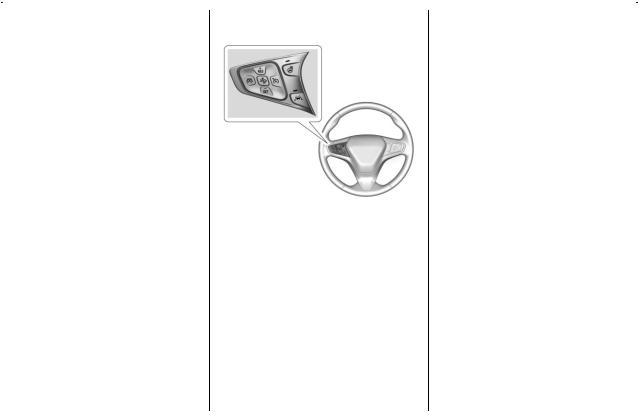
In Brief |
21 |
Vehicle Features
Infotainment System
See the infotainment manual for information on the radio, audio players, phone, and voice or speech recognition. It also includes information on settings.
Steering Wheel Controls
The infotainment system can be operated by using the steering wheel controls. See “Steering Wheel Controls” in the infotainment manual.
Cruise Control
1: Press to turn the cruise control system on and off. A white indicator comes on in the instrument cluster when cruise is turned on.
* : Press to disengage cruise control without erasing the set speed from memory.
+RES : If there is a set speed in memory, press briefly to resume that speed or press and hold to accelerate. If cruise control is already active, use to increase vehicle speed.
−SET : Press briefly to set the speed and activate cruise control. If cruise control is already active, use to decrease vehicle speed.
See Cruise Control 0 198.

22 In Brief
Driver Information
Center (DIC)
The DIC display is in the instrument cluster. It shows the status of many vehicle systems.
Uplevel DIC Controls
w or x : Press to move up or down in a list, or on the main view press to cycle through the different Info app pages.
o or p : Press to move between the interactive display zones in the cluster.
V : Press to open a menu or select a menu item. Press and hold to reset values on certain screens,
or on the main view reset info pages to the original setting.
See Instrument Cluster 0 115 and Driver Information Center (DIC) (Base Level) 0 132 or Driver Information Center (DIC) (Uplevel) 0 135.
Forward Collision Alert
(FCA) System
If equipped, FCA may help avoid or reduce the harm caused by front-end crashes. FCA provides a
green indicator, V, when a vehicle is detected ahead. This indicator displays amber if you follow a vehicle much too closely. When approaching a vehicle ahead too quickly, FCA provides a red flashing alert on the windshield and rapidly beeps.
See Forward Collision Alert (FCA)
System 0 204.
Forward Automatic
Braking (FAB)
If the vehicle has Forward Collision Alert (FCA), it also has FAB, which includes Intelligent Brake
Assist (IBA). When the system detects a vehicle ahead in your path that is traveling in the same direction that you may be about to crash into, it can provide a boost to braking or automatically brake the vehicle. This can help avoid or lessen the severity of crashes when driving in a forward gear.
See Forward Automatic Braking (FAB) 0 206.
Front Pedestrian Braking
(FPB) System
If equipped, the FPB system may help avoid or reduce the harm caused by front-end crashes with nearby pedestrians when driving in a forward gear. FPB displays an
amber indicator, ~, when a nearby pedestrian is detected directly ahead. When approaching a

In Brief |
23 |
detected pedestrian too quickly, FPB provides a red flashing alert on the windshield and rapidly beeps. FPB can provide a boost to braking or automatically brake the vehicle.
See Front Pedestrian Braking (FPB)
System 0 208.
Lane Keep Assist (LKA)
If equipped, LKA may help avoid crashes due to unintentional lane departures. It may assist by gently turning the steering wheel if the vehicle approaches a detected lane marking without using a turn signal in that direction. It may also provide a Lane Departure Warning (LDW) alert as the lane marking is crossed. The system will not assist or alert if it detects that you are actively steering. Override LKA by turning the steering wheel. LKA uses a camera to detect lane markings between 60 km/h (37 mph) and
180 km/h (112 mph).
See Lane Departure Warning (LDW) 0 212 and Lane Keep Assist (LKA) 0 212.
Lane Change Alert (LCA)
If equipped, the LCA system is a lane-changing aid that assists drivers with avoiding lane change crashes that occur with moving vehicles in the side blind zone (or spot) areas or with vehicles rapidly approaching these areas from behind. The LCA warning display will light up in the corresponding outside mirror and will flash if the turn signal is on. The Side Blind Zone Alert (SBZA) system is included as part of the LCA system.
See Side Blind Zone Alert (SBZA) 0 210 and Lane Change Alert (LCA) 0 210.
Rear Vision
Camera (RVC)
If equipped, RVC shows a view of the area behind the vehicle on the infotainment display when the vehicle is shifted into R (Reverse) to aid with parking and low-speed backing maneuvers.
See Assistance Systems for Parking or Backing 0 202.
Rear Cross Traffic Alert
(RCTA) System
If equipped, the RCTA system uses a triangle with an arrow on the infotainment display to warn of traffic behind your vehicle that may cross your vehicle's path while in R (Reverse). In addition, beeps will sound.
See Assistance Systems for Parking or Backing 0 202.
Park Assist
If equipped, Rear Park Assist (RPA) uses sensors on the rear bumper to assist with parking and avoiding objects while in R (Reverse).
It operates at speeds less than 8 km/h (5 mph). RPA may show a
warning triangle on the infotainment display and/or a graphic on the instrument cluster to provide the object distance. In addition, multiple beeps may occur if very close to an object.

24 In Brief
See Assistance Systems for Parking or Backing 0 202.
Power Outlets
The 12-volt accessory power outlet can be used to plug in electrical equipment, such as a cell phone or MP3 player.
There is an accessory power outlet on the center console in front of the shift lever. This outlet is powered when the ignition is on or in ACC/ ACCESSORY, or until the driver door is opened within 10 minutes of turning off the vehicle. See Retained Accessory Power (RAP) 0 180.
See Power Outlets 0 113.
Sunroof
If equipped, the sunroof only operates with the ignition on or in ACC/ACCESSORY, or when Retained Accessory Power (RAP) is active. See Retained Accessory Power (RAP) 0 180.
1.Slide Switch
2.Tilt Switch
Slide Switch
Express-Open/Express-Close : To express-open the sunroof,
press e(1) to the second detent position and release. To express-close the sunroof,
press g(1) to the second detent position and release. Press the switch again to stop.
Open/Close (Manual Mode) : To open the sunroof, press and hold e(1) until the sunroof reaches the desired position. Press and hold g(1) to close.
Tilt Switch
Vent : From the closed position, press f(2) to vent the sunroof. Press g(2) to close.
The sunroof also has an automatic reversal system.
See Sunroof 0 55.

In Brief |
25 |
Performance and
Maintenance
Traction Control/
Electronic Stability
Control
The Traction Control System (TCS) limits wheel spin. The system turns on automatically every time the vehicle is started.
The StabiliTrak/Electronic Stability Control (ESC) system assists with directional control of the vehicle in difficult driving conditions. The system also turns on automatically every time the vehicle is started.
.To turn off the TCS, press and release g on the center console. The traction off light i illuminates.
.To turn off both traction control and StabiliTrak/ESC, press and
hold g, until the traction off light i and the StabiliTrak/ESC OFF light g illuminate.
.Press and release g again to turn on both systems.
See Traction Control/Electronic
Stability Control 0 196.
Tire Pressure Monitor
This vehicle may have a Tire Pressure Monitor System (TPMS).
The low tire pressure warning light alerts to a significant loss in pressure of one of the vehicle's tires. If the warning light comes on, stop as soon as possible and inflate the tires to the recommended pressure shown on the Tire and Loading Information label. See
Vehicle Load Limits 0 166. The warning light will remain on until the tire pressure is corrected.
The low tire pressure warning light may come on in cool weather when the vehicle is first started, and then turn off as the vehicle is driven. This may be an early indicator that the tire pressures are getting low and the tires need to be inflated to the proper pressure.
The TPMS does not replace normal monthly tire maintenance. Maintain the correct tire pressures.
See Tire Pressure Monitor System 0 280.
Tire Fill Alert (If Equipped)
This feature provides visual and audible alerts outside the vehicle to help when inflating an underinflated tire to the recommended cold tire pressure. See “Tire Fill Alert (If Equipped)” under Tire Pressure Monitor Operation 0 281.
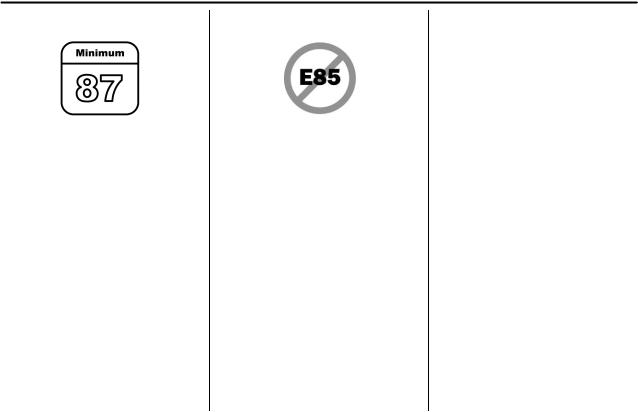
26 In Brief
Fuel (Gasoline)
Regular Unleaded Fuel
Use only Regular 87 octane — (R+M)/2 — or higher unleaded gasoline in your vehicle. TOP TIER Detergent Gasoline is recommended. Do not use gasoline with an octane rating lower as it will result in reduced performance and lower fuel economy. See
Recommended Fuel (Gasoline) 0 215.
Fuel (Diesel)
Use of diesel fuel with ultra low sulfur content (15 ppm, maximum) is required. See Fuel for Diesel Engines 0 216.
E85 or FlexFuel
No E85 or FlexFuel
Gasoline-ethanol fuel blends greater than E15 (15% ethanol by volume), such as E85, cannot be used in this vehicle.
Engine Oil Life System
The engine oil life system calculates engine oil life based on vehicle use and displays the CHANGE ENGINE OIL SOON message when it is time to change the engine oil and filter.
The oil life system should be reset to 100% only following an oil change.
Resetting the Oil Life System
(Base Level Cluster)
1.Display the REMAINING OIL LIFE on the DIC. See Driver Information Center (DIC) (Base Level) 0 132 or Driver Information Center (DIC) (Uplevel) 0 135.
2.Press and hold SET/CLR on the turn signal lever while the Oil Life display is active. The oil life will change to 100%.
Resetting the Oil Life System
(Uplevel Cluster)
1.Display the REMAINING OIL LIFE on the DIC. See Driver Information Center (DIC) (Base Level) 0 132 or Driver Information Center (DIC) (Uplevel) 0 135.
2.Press and hold V on the DIC while the Oil Life display is active. The oil life will change to 100%.

In Brief |
27 |
The oil life system can also be reset as follows:
1.Turn the ignition on with the engine off. See Ignition Positions (Keyless Access)
0 171 or Ignition Positions (Key Access) 0 172.
2.Fully press and release the accelerator pedal three times within five seconds.
See Engine Oil Life System 0 240.
Driving for Better Fuel Economy
Driving habits can affect fuel mileage. Here are some driving tips to get the best fuel economy possible:
.Set the climate controls to the desired temperature after the engine is started, or turn them off when not required.
.Avoid fast starts and accelerate smoothly.
.Brake gradually and avoid abrupt stops.
.Avoid idling the engine for long periods of time.
.When road and weather conditions are appropriate, use cruise control.
.Always follow posted speed limits or drive more slowly when conditions require.
.Keep vehicle tires properly inflated.
.Combine several trips into a single trip.
.Replace the vehicle's tires with the same TPC Spec number molded into the tire's sidewall near the size.
.Follow recommended scheduled maintenance.
Roadside Assistance
Program
U.S.: 1-800-243-8872
TTY Users (U.S. Only): 1-888-889-2438
Canada: 1-800-268-6800
New Chevrolet owners are automatically enrolled in the Roadside Assistance Program.
See Roadside Assistance Program 0 346.

28 Keys, Doors, and Windows
Keys, Doors, and
Windows
Keys and Locks
Keys . . . . . . . . . . . . . . . . . . . . . . . . . . . 28
Remote Keyless Entry (RKE)
System . . . . . . . . . . . . . . . . . . . . . . . 31
Remote Keyless Entry (RKE)
System Operation (Keyless
Access) . . . . . . . . . . . . . . . . . . . . . . 31
Remote Keyless Entry (RKE)
System Operation (Key
Access) . . . . . . . . . . . . . . . . . . . . . . 38
Remote Vehicle Start . . . . . . . . . . 40
Door Locks . . . . . . . . . . . . . . . . . . . . 42
Power Door Locks . . . . . . . . . . . . . 44
Delayed Locking . . . . . . . . . . . . . . . 44
Automatic Door Locks . . . . . . . . . 44
Lockout Protection . . . . . . . . . . . . . 44
Safety Locks . . . . . . . . . . . . . . . . . . . 45
Doors
Trunk . . . . . . . . . . . . . . . . . . . . . . . . . . 46
Liftgate . . . . . . . . . . . . . . . . . . . . . . . . 47
Vehicle Security
Immobilizer Operation (Key
Access) . . . . . . . . . . . . . . . . . . . . . . 50
Immobilizer Operation (Keyless
Access) . . . . . . . . . . . . . . . . . . . . . . 51
Exterior Mirrors
Convex Mirrors . . . . . . . . . . . . . . . . 52
Power Mirrors . . . . . . . . . . . . . . . . . . 52
Folding Mirrors . . . . . . . . . . . . . . . . . 52
Heated Mirrors . . . . . . . . . . . . . . . . . 52
Interior Mirrors
Interior Rearview Mirrors . . . . . . . 53
Manual Rearview Mirror . . . . . . . . 53
Windows
Windows . . . . . . . . . . . . . . . . . . . . . . . 53
Power Windows . . . . . . . . . . . . . . . 53
Sun Visors . . . . . . . . . . . . . . . . . . . . . 55
Roof
Sunroof . . . . . . . . . . . . . . . . . . . . . . . . 55
Keys and Locks
Keys
{Warning
Leaving children in a vehicle with an ignition key or Remote Keyless Entry (RKE) transmitter is dangerous and children or others could be seriously injured or killed. They could operate the power window or other controls or make the vehicle move. The windows will function with the key in the ignition or with the RKE transmitter in the vehicle, and children or others could be caught in the path of a closing window. Do not leave children in a vehicle with the ignition key or an RKE transmitter.
Vehicle Security . . . . . . . . . . . . . . . . 49
Vehicle Alarm System . . . . . . . . . 49
Immobilizer . . . . . . . . . . . . . . . . . . . . 50

Keys, Doors, and Windows 29
{Warning
If the key is unintentionally rotated while the vehicle is running, the ignition could be moved out of the RUN position. This could be caused by heavy items hanging from the key ring, or by large or long items attached to the key ring that could be contacted by the driver or steering wheel. If the ignition moves out of the RUN position, the engine will shut off, braking and steering power assist may be
(Continued)
Warning (Continued)
impacted, and airbags may not deploy. To reduce the risk of unintentional rotation of the ignition key, do not change the way the ignition key and Remote Keyless Entry (RKE) transmitter, if equipped, are connected to the provided key rings.
The ignition key and key rings, and RKE transmitter, if equipped, are designed to work together as a system to reduce the risk of
unintentionally moving the key out of the RUN position. The ignition key has a small hole to allow attachment of the provided key ring. It is important that any replacement ignition keys have a small hole. See your dealer if a replacement key is required. The combination and size of the rings that came with your keys were specifically selected for your vehicle. The rings are connected to the key like two links of a chain to reduce the risk of unintentionally moving the key out of the RUN position. Do not add any additional items to the ring attached to the ignition key. Attach additional items only to the second ring, and limit added items to a few essential keys or small, light items no larger than an RKE transmitter.
